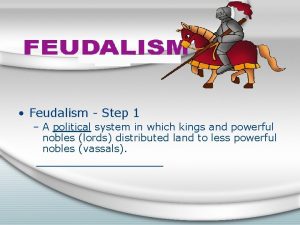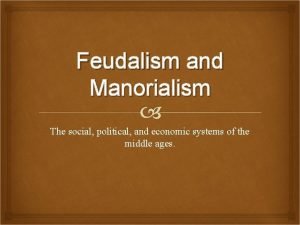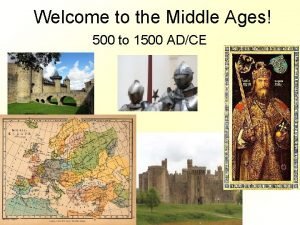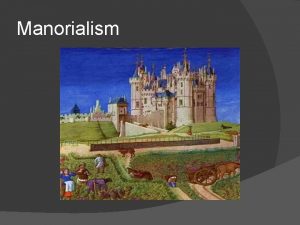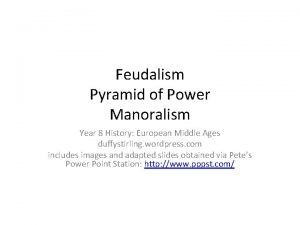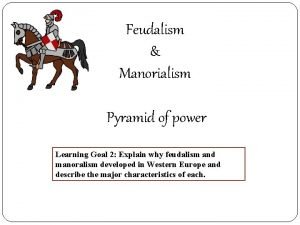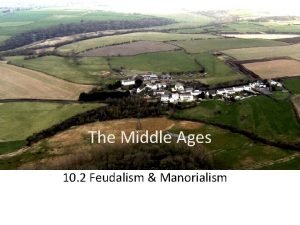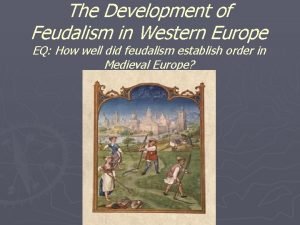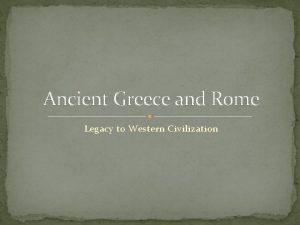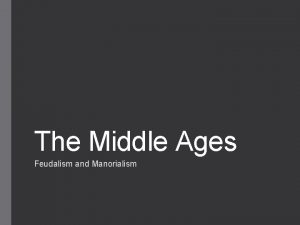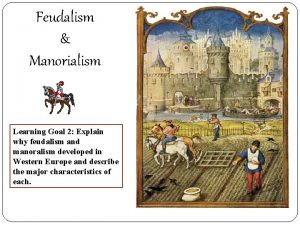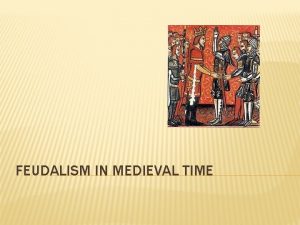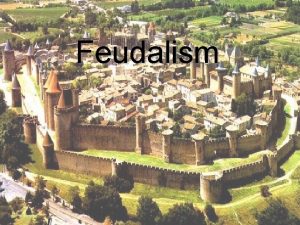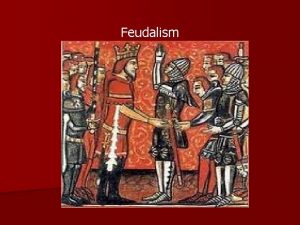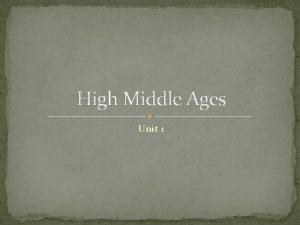Feudalism and Manorialism Western Civilization University High School












- Slides: 12

Feudalism and Manorialism Western Civilization University High School 2011 -12

Post-Charlemagne � Frankish kingdom Charlemagne’s son contention among 3 grandsons � Treaty of Verdun: divided empire into 3 parts Charlemagne = last large unified state in Europe (Hitler, Napoleon? )

Feudalism �decentralized Frankish power increased localized power �nobles owned lots of land, gained military followings oaths of loyalty to nobles made followers into vassals (Celtic word for “servant”) nobles became lords

Feudalism �vassals gave aid (military & otherwise), support, & loyalty to lord �lords gave protection to vassals fief: land that vassals lived on (but still belonged to lord) ▪ included towns, churches, farms, forests, etc. �***Feudalism was all about personal loyalties at local level, not loyalty to some distant unknown king. ***


Manorialism �most Middle Ages Europeans were not in feudal systems… �manorialism: people lived in manors (Latin for “dwelling”) family groups in villages, small towns �still a relationship between lords and vassals

Manorialism �when entering relationship with lord, farmers lost free status (“serfs”) bound to land, could not leave without lord’s permission not quite slavery (didn’t own the person), but serfs subject to lord’s rules & laws

Results of Feudalism & Manorialism �moderate population growth reduced forests, wild lands �nobles lived well (clothes, heated homes) males hunted & managed estates females raised children, education (sometimes even became nobles themselves) �serfs/vassals dependence, not much opportunity for social advancement

It’s Good to be King

Feudalism activity �Step 1: Draw a role 1 King 4 Nobles 28 Serfs �Step 2: Organize classroom into 4 manors, with a Noble in charge of each. All 4 Nobles answer to the King. �Step 3: Distribute money (M&Ms) and banks (plastic cups) to everyone.

Feudalism activity �Step 4: Get to work! Serfs must plant crops to earn money ▪ 1 piece of paper tile (elbows only!) go back to desk and make a checkmark �Step 5: Get paid! Serfs get 4 M&Ms for each crop planted. Serfs may keep 1 of those 4 M&Ms. The other 3 go to their Noble. For each 3 M&Ms that a Noble receives, 2 must go to the King.

Feudalism activity discussion questions � 1. How many M&Ms did everyone end up with? � 2. Is feudalism a fair system? � 3. Why do you think that feudalism worked? � 4. What need would the nobles and king have for all that food and material?
 Feudalism
Feudalism Feudalism and manorialism venn diagram
Feudalism and manorialism venn diagram Difference between feudalism and manorialism
Difference between feudalism and manorialism Feudalism and manorialism venn diagram
Feudalism and manorialism venn diagram What is manorialism
What is manorialism Anglo-saxon hierarchy pyramid
Anglo-saxon hierarchy pyramid Feudal pyramid
Feudal pyramid Manorialism def
Manorialism def The development of feudalism in western europe
The development of feudalism in western europe Rome and the roots of western civilization
Rome and the roots of western civilization Rome and the roots of western civilization
Rome and the roots of western civilization Case western reserve university case school of engineering
Case western reserve university case school of engineering Wmu msw application
Wmu msw application

